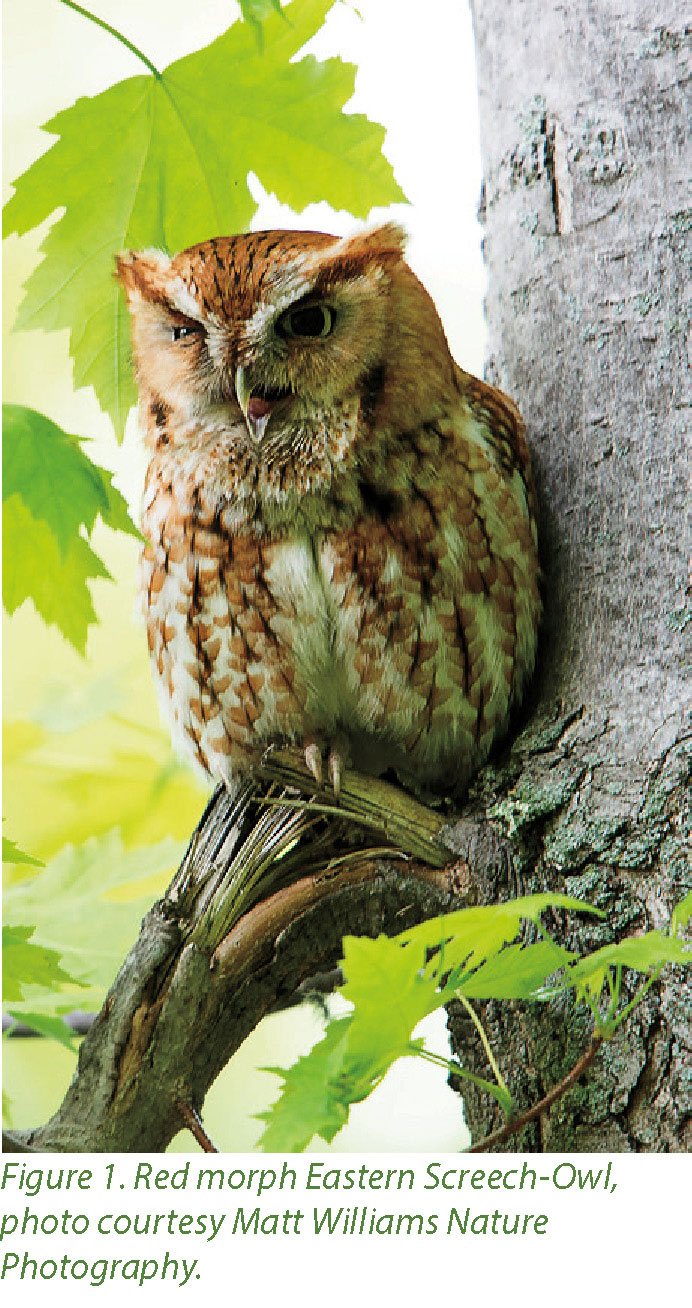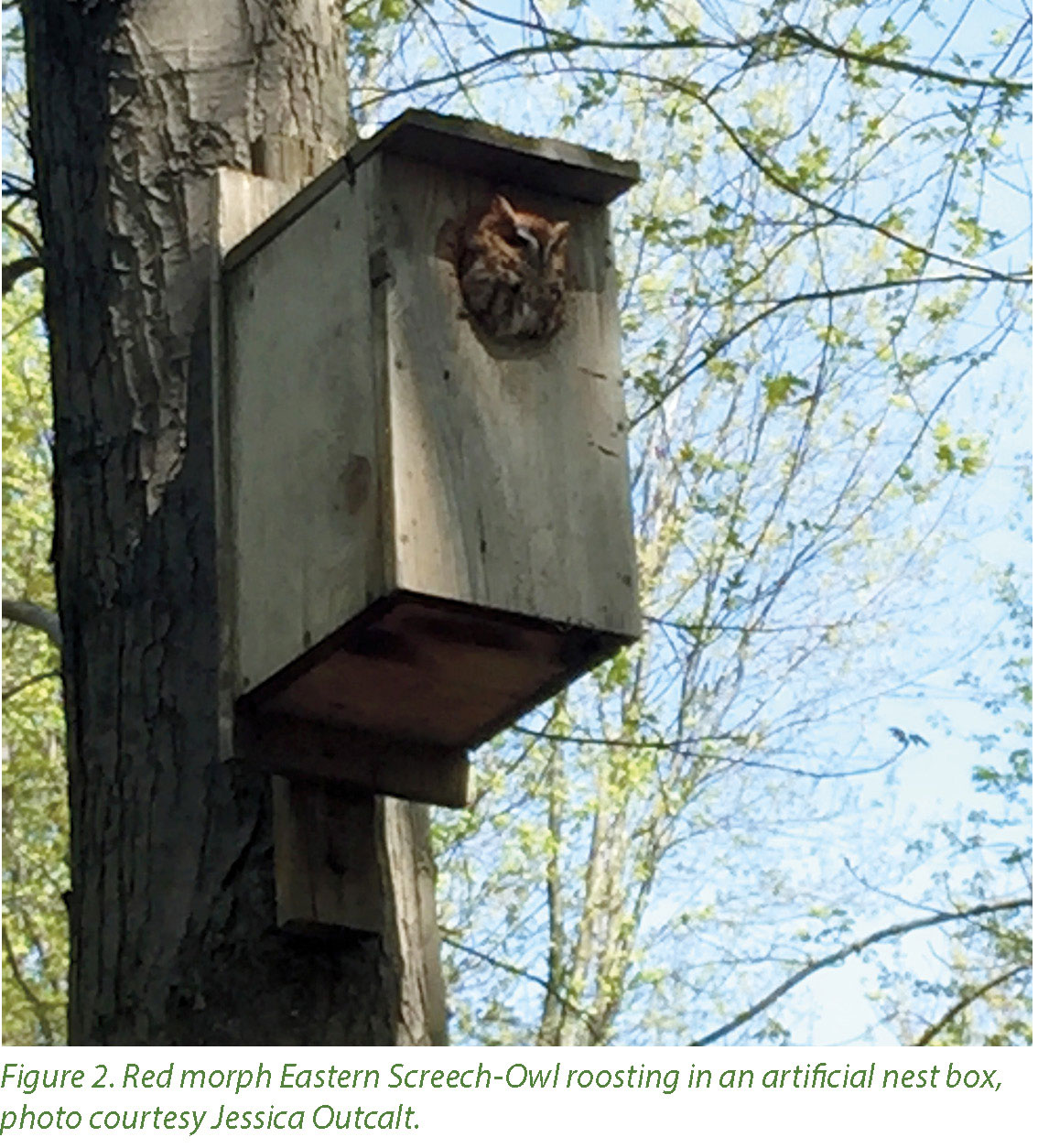The Birders’ Dozen Profile 7: Eastern Screech-Owl
Welcome to the Birders’ Dozen! Over the next six issues we are going to continue introducing the last half of the bird species from Forestry for the Birds. The Birders’ Dozen are forest birds that can benefit from targeted management practices, as most are declining due to habitat loss. We’ve curated this list to cover a wide range of habitat types, from young to mature forest, open to closed canopy, or dense to non-existent shrub layers. Our goal is to engage landowners and foresters in the process of managing forests for wildlife, or “forests for the birds.”
This tiny owl, most commonly seen poking its head out of a hole in a tree, is a distinctive predator. Unlike many species, the Eastern Screech-Owl does not have a minimum area needed for habitat; its only requirement is a cavity tree for nesting. Despite being relatively general in its habitat selection, some management techniques can help encourage owl residence in a given area, allowing landowners to enjoy its charismatic presence.
Natural History
Though its habitat is relatively general and owls are dependent only on a cavity tree or nest box, this non-migratory bird is also influenced by food availability and adequate hunting habitat. Rodents and songbirds are the screech owl’s primary prey, though invertebrates including insects, crayfish, and earthworms are also important. These food items can change seasonally: in the winter, rodents are more commonly consumed, while birds and invertebrates are more common during the nesting season. In addition, mammals are more typical prey in rural areas, but owls can consume more small birds in urban areas.
The Eastern Screech-Owl is a sit-and-wait predator, which means they typically wait on a perch until they see suitable prey and then strike rapidly and silently. Because of this hunting strategy, open subcanopies, thin shrub layers, and small clearings provide ideal habitat. Like most owls, this tiny owl is active primarily at night, but can be active at dawn and dusk as well.
Unlike other owls in North America, the Eastern Screech-Owl displays a unique plumage pattern: two distinct color morphs, red and gray. Red owls are more common in southern parts of their range, while gray owls are more common in the north. Though color may play a role in owls’ temperature control (red feathers are less insulating than darker gray ones), the two morphs otherwise act similarly. Owls of each color can breed with one another and each has the same calls.
Screech owls are monogamous, and pairs remain mated for life, despite individuals being solitary throughout the majority of the year. Male owls will defend a territory containing at least two or more cavities, from which females choose a suitable option. Natural cavities include hollow trunks, limbs, or woodpecker-created holes, though owls will often use artificial nest boxes. A clutch of 3-4 eggs are laid directly on debris or old squirrel or bird nests, and are incubated for around 4 weeks. After the chicks hatch, they are fed by both parents until they fledge around 4 weeks later. Owl fledglings, unlike songbird fledglings, are dependent on the parents for a long period of time, up to 10 weeks in some cases. If a clutch is successful, nest cavities or boxes will likely be reused in subsequent years.
Habitat Management
Non-migratory and largely solitary, even a small forest patch may support a family of Eastern Screech-Owls. These tiny owls use primarily deciduous woodlots and edge habitats, but can successfully breed in any wooded habitat. Owls sometimes prefer upland and maple woodlands, and use lawns and evergreen woodlands less frequently. Management for screech-owls, then, should include retention of trees with suitable cavities or provision of nest boxes, as well as encouraging open woodlands for hunting.
White-footed mice (Peromyscus leucopus) are important prey items for owls, and mice populations are often tied to acorn (mast) production. Encouraging growth of native oak and other mast-producing tree species can not only provide roosting and nesting trees but food items for owls’ prey as well. When oak growth is coupled with an open understory and other clearings for hunting opportunities, growing owl populations could be sustained.
The most important requirement for Eastern Screech-Owls, however, is simply the provision of a suitable cavity tree or nest box. Owls do not excavate their own cavities, so if no suitable natural cavity—such as one created by another of our target species, the Red-headed Woodpecker—exists, a nest box can be provided. The Cornell Lab of Ornithology’s citizen science project NestWatch and the National Audubon Society, both listed in References below, provide useful tips and plans for building your own nest box, as well as suggesting ideal locations within your property.
Conclusion
This tiny but fierce predator is a favorite of many. In my local nature preserve, a pair of screech owls, one gray and one red, have been roosting in the same cavity for over a year. They’ve become local celebrities among the birding community here, and seeing their faces peek out of the cavity, sometimes both at once, is a captivating experience. Declining owl populations can greatly benefit from management and forest conservation, so that future generations can experience the joy of seeing a tiny owl face peer out of a tree.
Special thanks to the Alcoa Foundation, the Indiana Forestry Educational Foundation, and The Nature Conservancy for their support and leadership of Forestry for the Birds.
Jessica Outcalt is the Agriculture and Natural Resources / Community Development Extension Educator with Purdue Extension in Cass County, and has been with Extension since spring 2022. Prior to her work with Extension, she worked with The Nature Conservancy to develop this series of profiles, as well as the pocket guide and assisting with the silvicultural guide for Forestry for the Birds. She completed her BS in biology at Taylor University, her PhD in wildlife ecology at Purdue University, and is passionate about birds and getting people involved in conservation and the scientific process.
References
Cornell Lab of Ornithology. 2022. “Eastern Screech-Owl.” NestWatch. nestwatch.org, Accessed March 2022. https://nestwatch.org/learn/all-about-birdhouses/birds/eastern-screech-owl/.
Leonard, Olivia D., Jonathan W. Moore, Jeffery K. Riegel, Andrew R. Meier, John B. Dunning, Kenneth F. Kellner, and Robert K. Swihart. 2015. “Effect of variation in forest harvest intensity on winter occupancy of Barred Owls and Eastern Screech-Owls in deciduous forests of the east-central United States.” Journal of Field Ornithology 86 (2): 115–29. https://doi.org/10.1111/jofo.12095.
National Audubon Society. 2022. “How to Build a Screech-Owl Nest Box.” Accessed March 2022. https://www.audubon.org/news/how-build-screech-owl-nest-box.
Ritchison, Gary, Frederick R. Gehlbach, Peter Pyle, and Michael A. Patten. 2020. “Eastern Screech-Owl (Megascops Asio).” Birds of the World, March. https://birdsoftheworld.org/bow/species/easowl1/cur/introduction.
Sparks, Earl J., James R. Belthoff, and Gary Ritchison. 1994. “Habitat Use by Eastern Screech-Owls in Central Kentucky (Habitat Utilizado Por Otus Asio in La Parte Central de Kentucky).” Journal of Field Ornithology 65 (1): 83–95.
